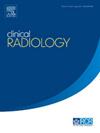Usefulness of balanced steady-state free precession for portosystemic shunts prior to balloon-occluded retrograde transvenous obliteration
IF 1.9
3区 医学
Q2 RADIOLOGY, NUCLEAR MEDICINE & MEDICAL IMAGING
引用次数: 0
Abstract
AIM
This study visualised portosystemic shunts (PSSs), referring to gastrorenal or splenorenal shunts, on balanced steady-state free precession (bSSFP) imaging and assessed its accuracy compared with contrast-enhanced computed tomography (CECT).
MATERIALS AND METHODS
Patients with bSSFP and CECT imaging of a PSS prior to balloon-occluded retrograde transvenous obliteration from March 2017 to September 2021 were included. The quality of both images was graded based on whether the entire PSS pathway from the afferent vein to the efferent vein was traceable as “well-visualised,” “poorly visualised,” or “not visualised.” Factors contributing to well-visualised on bSSFP images were investigated, including sex, age, height, weight, diagnosis (gastric varices or hepatic encephalopathy), type of PSS, maximum short-axis diameter of the PSS, signal intensity of the surrounding tissue around the PSS, and motion artifacts. Visualisation of collateral drainage veins of the PSS was also evaluated.
RESULTS
Ten of 22 cases were graded well-visualised, 9 poorly visualised, and 3 not visualised on bSSFP images, whereas all cases were graded well-visualised on CECT. There was a significant difference between the two imaging modalities for well-visualised images (P<.001). Univariate analyses identified signal intensity of the surrounding tissue around the PSS and motion artifacts as factors contributing to well-visualised on bSSFP images (both P<.05). Multivariate analysis also showed that the former factor contributed to well-visualised images (P<.001). Of 30 collateral veins visualised on balloon-occluded retrograde transvenous venography , 13 were seen on bSSFP and 20 on CECT.
CONCLUSION
Though bSSFP imaging is a potential alternative for visualising PSS, it is less effective than contrast-enhanced computed tomography.
平衡稳态自由进动在球囊闭塞逆行经静脉闭塞前门静脉分流术中的应用
目的:本研究在平衡稳态自由进动(bSSFP)成像上可视化门系统分流(pss),指的是胃肾或脾肾分流,并与对比增强计算机断层扫描(CECT)相比评估其准确性。材料和方法纳入2017年3月至2021年9月期间,在球囊闭塞逆行经静脉闭塞术之前接受bSSFP和CECT成像的PSS患者。根据从传入静脉到传出静脉的整个PSS通路是否可追溯,这两幅图像的质量被分级为“良好可见”、“不良可见”或“不可见”。我们研究了bSSFP图像上显示良好的因素,包括性别、年龄、身高、体重、诊断(胃静脉曲张或肝性脑病)、PSS类型、PSS最大短轴直径、PSS周围组织的信号强度和运动伪影。还评估了PSS侧支引流静脉的可视化。结果22例bSSFP图像显示良好,9例显示不良,3例未显示,而CECT均显示良好。两种成像方式对于视觉效果良好的图像有显著差异(P< 0.001)。单变量分析确定了PSS周围组织的信号强度和运动伪影是有助于bSSFP图像良好可视化的因素(P< 0.05)。多变量分析还表明,前一个因素有助于良好的可视化图像(P<.001)。球囊闭塞逆行经静脉造影显示的30条侧静脉中,bSSFP显示13条,CECT显示20条。结论虽然bSSFP成像是一种潜在的PSS可视化替代方法,但其效果不如增强ct。
本文章由计算机程序翻译,如有差异,请以英文原文为准。
求助全文
约1分钟内获得全文
求助全文
来源期刊

Clinical radiology
医学-核医学
CiteScore
4.70
自引率
3.80%
发文量
528
审稿时长
76 days
期刊介绍:
Clinical Radiology is published by Elsevier on behalf of The Royal College of Radiologists. Clinical Radiology is an International Journal bringing you original research, editorials and review articles on all aspects of diagnostic imaging, including:
• Computed tomography
• Magnetic resonance imaging
• Ultrasonography
• Digital radiology
• Interventional radiology
• Radiography
• Nuclear medicine
Papers on radiological protection, quality assurance, audit in radiology and matters relating to radiological training and education are also included. In addition, each issue contains correspondence, book reviews and notices of forthcoming events.
 求助内容:
求助内容: 应助结果提醒方式:
应助结果提醒方式:


